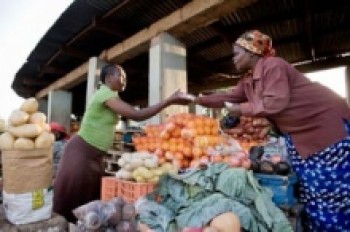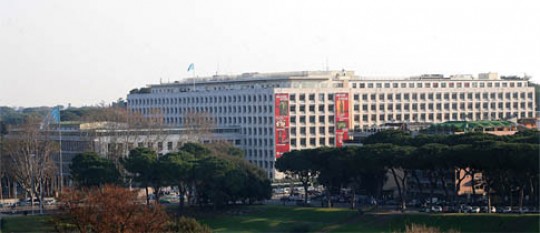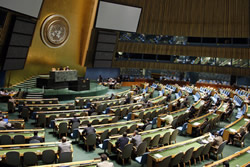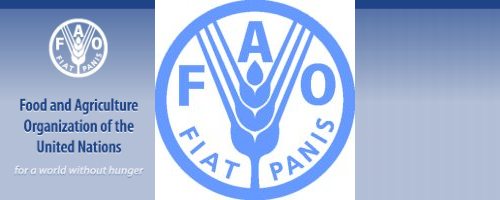FAO Food Price Index almost unchanged But cereal prices up in August
FAO Food Price Index almost unchanged
But cereal prices up in August
 Rome – World food prices remained virtually unchanged between July and August 2011 according to the FAO Food Price Index published today.
Rome – World food prices remained virtually unchanged between July and August 2011 according to the FAO Food Price Index published today.
The Index averaged 231 points last month compared to 232 points in July. It was 26 percent higher than in August 2010 but seven points below its all-time high of 238 points in February 2011.
Within the index, cereals prices rose, reflecting the fact that although cereal production is expected to increase, it will not do so by enough to offset the additional demand, so that stocks continue to be low and prices continue to be high and volatile.
The FAO Cereal Price Index averaged 253 points in August, up 2.2 percent, or 5 points, from July and 36 percent higher than in August 2010. However, the firmer cereal prices were largely offset by declines in international prices of most other commodities included in the Food Price Index, oils and dairy products in particular.
Production rebound
Cereal price rises stem from a supply and demand balance that remains tight despite the anticipated increase in production. World cereal production in 2011 is now forecast to reach 2 307 million tonnes, 3 percent higher than in 2010. But this latest forecast is nearly 6 million tonnes lower than the previous forecast published in July.
Among the major cereals, the maize supply situation is a cause for concern following downward revisions to maize crop prospects in the United States, the world’s largest maize producer, because of continued hot weather in July and August.
Average wheat prices were also up 9 percent in August given the strong demand for feed wheat and shrinking supplies of high quality wheat. Nonetheless, world wheat production is forecast to increase by 4.3 percent (or 28 million tonnes), only 4 million tonnes below the 2009 record.
World coarse grain production is still heading for a record level of 1 147.5 million tonnes, up 2.4 percent (or 27 million tonnes) from 2010, in spite of lowered maize production prospects in the United States, the world’s largest maize producer.
Rice price gains
Rice prices also gained with the benchmark Thai rice price up 5 percent from July, driven by a policy change in Thailand, the world’s largest rice exporter, where paddy rice will be purchased from farmers at above market prices.
Global rice production prospects remain favourable, however, with output set to reach a new high of 479 million tonnes, up 2.5 percent from 2010.
Low inventories
Total cereal utilization in 2011/12 is forecast to increase by 1.4 percent, almost matching anticipated 2011 production. As a result, global cereal inventories by the close of seasons in 2012 are likely to remain close to their already low opening levels. Only rice stocks are expected to increase significantly, supported by record production.
Wheat inventories are likely to decline to their lowest level since 2009 and world stocks of coarse grains are also forecast to plunge, with maize inventories falling to 124 million tonnes, their lowest level since 2007. Given the tight global supply and demand balance for coarse grains, its stocks-to-use ratio is forecast to fall to a historical low of 13.4 percent.
The FAO Oils/Fats Price Index averaged 244 points in August, following a declining trend since March but still remaining high in historical terms.
The FAO Dairy Price Index averaged 221 points in August, significantly down from 228 points in July and 232 points in June, but still 14 percent higher than the same period last year.
The FAO Meat Price Index averaged 181 points in August, up 1 percent from July.
The FAO Sugar Price Index averaged 394 points in August, down 2 percent from July, but still 50 percent higher than in August 2010.
###
> UN Food and Agriculture Organization (FAO).
The Food and Agriculture Organization of the United Nations (FAO) is an intergovernmental organization and has 191 Member Nations, two associate members and one member organization, the European Union. Achieving food security for all is at the heart of FAO’s efforts – to make sure people have regular access to enough high-quality food to lead active, healthy lives.

FAO’s mandate is to raise levels of nutrition, improve agricultural productivity, better the lives of rural populations and contribute to the growth of the world economy.
The Food and Agriculture Organization of the United Nations (FAO) is working with its Members and the entire international community for achievement of the Millennium Development Goals.
These eight goals – each with specific targets and indicators – are based on the United Nations Millennium Declaration, signed by world leaders in September 2000. They commit the international community to combating poverty, hunger, disease, illiteracy, environmental degradation, and discrimination against women.
![]()
The eight Millennium Development Goals are:
Goal 1: Eradicate extreme poverty and hunger
Goal 2: Achieve universal primary education
Goal 3: Promote gender equality and empower women
Goal 4: Reduce child mortality
Goal 5: Improve maternal health
Goal 6: Combat HIV/AIDS, malaria and other diseases
Goal 7: Ensure environmental sustainability
Goal 8: Develop a Global Partnership for Development
* More information at UN Food and Agriculture Organization (FAO)
###
> United Nations (UN).
 The United Nations was established on 24 October 1945 by 51 countries committed to preserving peace through international cooperation and collective security. Today, nearly every nation in the world belongs to the UN: membership totals 192 countries.
The United Nations was established on 24 October 1945 by 51 countries committed to preserving peace through international cooperation and collective security. Today, nearly every nation in the world belongs to the UN: membership totals 192 countries.
When States become Members of the United Nations, they agree to accept the obligations of the UN Charter, an international treaty that sets out basic principles of international relations. According to the Charter, the UN has four purposes:
- to maintain international peace and security;
- to develop friendly relations among nations;
- to cooperate in solving international problems and in promoting respect for human rights;
- and to be a centre for harmonizing the actions of nations.
###
* The above story is adapted from materials provided by United Nations (UN)
** More information at United Nations (UN)





















